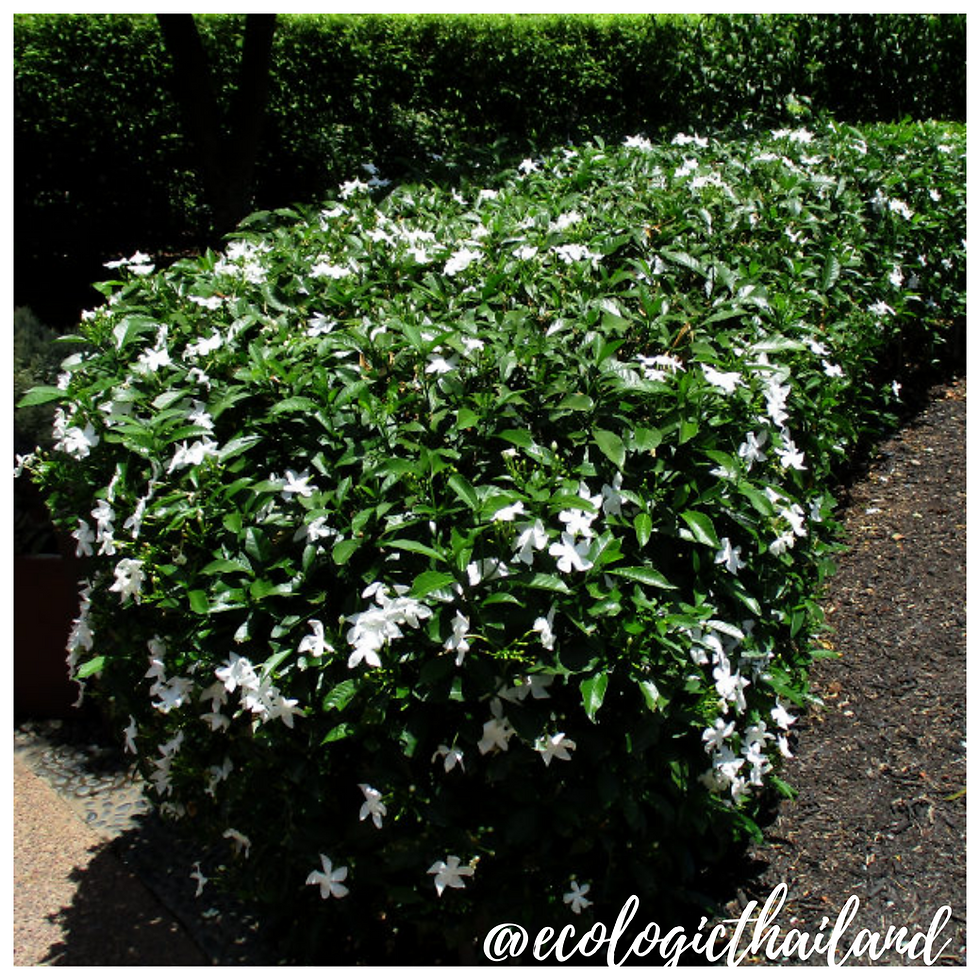Ti Plant
- Eco-Logic Resort
- Jan 15, 2021
- 3 min read
Makphumakmia | หมากผู้หมากเมีย | Cordyline fruticosa
Family: Asparagaceae - Genus: Cordyline

The Ti plant can be found all over the premises of Eco-Logic and TCDF alongside the paths.
The Ti plant is an evergreen flowering plant.. It is cultivated as an ornamental plant for its variously colored leaves, but also cultivated for food and traditional medicine. It is known by a wide variety of common names, including ti plant, palm lily, cabbage palm, and good luck plant. It grows from 1 - 5 meters tall.
The leaves are smooth, hairless, lanceolate to oblong-elliptic in shape, up to 60 centimeter long, alternate, and bright green, red, blackish red, reddish purple, pink, brown, or variegated with yellow, cream, or a combination of colors.
The Ti plant flowers at the beginning of the dry season.

THE PLANT
The Ti plant is an evergreen flowering plant.. It is cultivated as an ornamental plant for its variously colored leaves, but also cultivated for food and traditional medicine. It is known by a wide variety of common names, including ti plant, palm lily, cabbage palm, and good luck plant. It grows from 1 - 5 meter tall.

THE LEAVES
The leaves of the Ti plant are smooth, hairless, lanceolate to oblong-elliptic in shape, up to 60 centimeter long, alternate, and bright green, red, blackish red, reddish purple, pink, brown, or variegated with yellow, cream, or a combination of colors.
The leaves are spirally arranged into a fanlike shape at the stem tips. The stems are slender, upright, usually unbranched, and ringed with leaf scars.
Ti leaves, when used as a wrap in cooked preparations, impart a subtle grassy flavor and aroma.

THE FLOWERS
The Ti plant sometimes produces flowers, and more commonly when grown outside. The flowers appear in clusters in shades of pink or white and are very fragrant. The flowers are quite small, usually around half an inch in width.
The numerous small, 6-lobed flowers are in branched, drooping panicles. The flowers are sometimes followed by small, rounded, shiny, red fruit. Ti plants with green leaves rarely produce fruit and are instead usually propagated by stem cuttings.

THE BERRIES
The plant also produces fruit in the form of red berries., they are are dry & fleshy. The fruits, which are not uncommon, are round berries less than 1 ⁄2 inch in diameter containing many seeds. The fruit cover is fleshy and may be green, yellow, red, or scarlet. Some cultivars have red flowers and large scarlet berries.

THE ROOTS
The roots of the Ti plant can be used as a food source. The young roots are starchy and sweet and can be eaten much like a potato. They have also been fermented and turned to beer-like drink.
The tuberous root can weigh 4.5 - 6.5 kilos.
CULINARY USES
The root contains a high proportion of sugars. When baked, it has a flavor not unlike molasses and is eaten like this or used as a sweetener in puddings and other food. The root is baked for up to four days in earthen ovens to be consumed as food, sweets, refreshment, or confectionery.
Young leaves are cooked and eaten as a potherb[
They are free of any pronounced flavor and can also be used to wrap around other foods whilst they are baked
TRADITIONAL MEDICINAL USE OF NEEDLE FLOWER
NOTE: please take advice from a doctor if you are planning to use herbal medicine.
Traditionally the plant has been found to represent itself as a treatment option for various disorders, such as fever, headache, diarrhea, coughs, haemoptysis, small pox, madness, skin eruptions.
It is also used in joint pains, rheumatic bone pains and swelling pain which are originated from sprains. The leaves and stem of this medicinal plant was also used for abortion
INTO THE WILD: a down to earth experience

For guests and visitors to Paksong we organize weekly tours "The Edible Forest" and Foraging weekends: Into the Wild. We work with local guides to take you in the jungle of Paksong. After foraging, we will cook a meal with the ingredients, using bamboo together with you!
Come and join and learn about the abundance of food that nature gives us!
INTO THE WILD!


















Comments